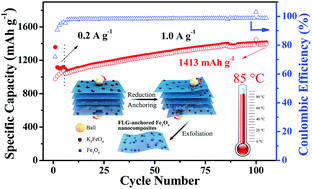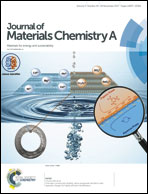Remarkable high-temperature Li-storage performance of few-layer graphene-anchored Fe3O4 nanocomposites as an anode†
Abstract
Herein, a novel and efficient strategy was established to synthesize few-layer graphene-anchored Fe3O4 nanocomposites (FLG-anchored Fe3O4) through a facile ball-milling route followed by annealing treatment. The as-prepared FLG-anchored Fe3O4 nanocomposites, as an anode material of LIBs, presented remarkable electrochemical performances at a high temperature of 85 °C, i.e., an excellent reversible capacity of 1413 mA h g−1 at a current density of 1.0 A g−1 after 100 cycles and an impressive rate performance of 768 mA h g−1 at a large current density of 5.0 A g−1 even after 100 cycles. These superior performances can be considered as a comprehensive consequence of the following factors: (1) the robust anchor between in situ synthesized Fe3O4 nanoparticles and few-layer graphene via a Fe–O–C linkage maintains structural integrity, enabling excellent cycling stability even at high temperatures; (2) accelerated dynamic diffusion of Li+ ions during lithiation/delithiation at 85 °C leads to a decreased polarization effect, producing enhanced reversibility; (3) enhanced pseudocapacitive behaviour at high temperatures holds partial capacity contribution. Due to these attributes, this material is a reliable and promising candidate for an anode material for heavy-duty Li-ion batteries that operate under harsh environments.



 Please wait while we load your content...
Please wait while we load your content...